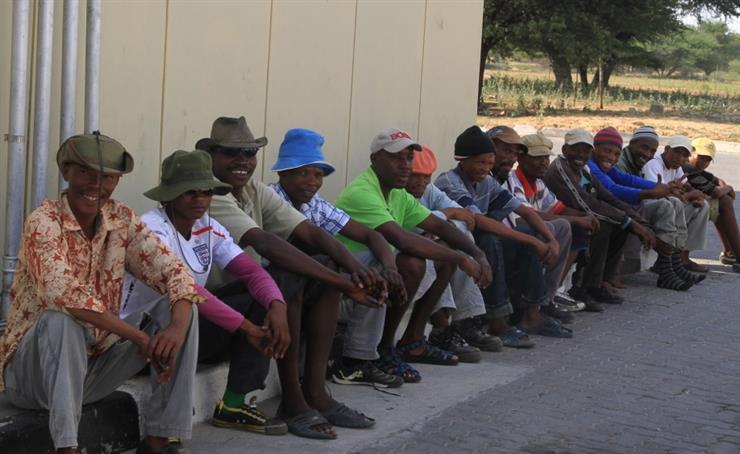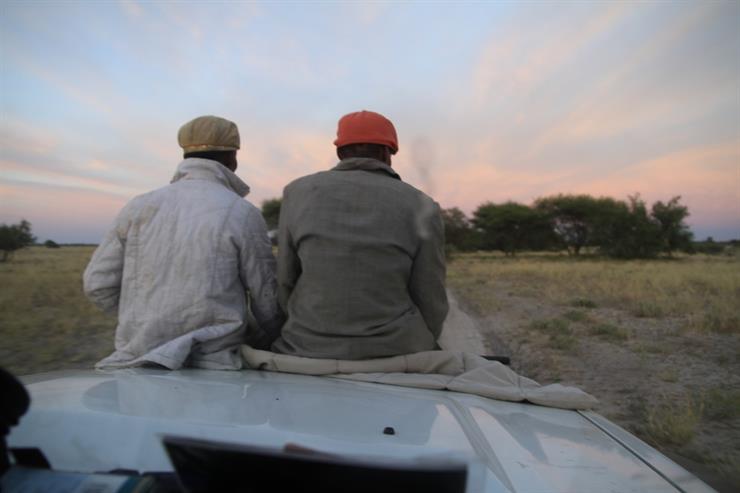Spoor Survey in the Kalahari Botswana
Large Carnivore Spoor Survey
Since 2012, Comanis has supported a collaborative research effort involving the Maun-based Kalahari Research and Conservation Group, and several volunteers. The purpose is to annually survey an extensive area of the Kalahari ecosystem for large carnivores based on detecting and counting their tracks (spoor). The survey routes are specifically designed to obtain continuous coverage of the unfenced Kalahari ecosystem stretching from the Nossob riverbed in the southwest of Kgalagadi Transfrontier Park (KTP), to Kuke corner in the northeast of Central Kalahari Game Reserve (CKGR).
Comanis provides technical expertise and logistical support by way of personnel and several research vehicles. More importantly, the annual event employs 14 trackers from the remote village of Zutshwa. When inquiries were initially made at the households of potential trackers to ask if they would like tracking jobs, one young man said, "You are the first ever to approach us and ask for our help with anything". Another said, "I no longer want to be a poacher, I want to be a researcher."
Most of these young men grew up subsistence hunting on the Government issued Special Game Licences. Since the discontinuation of these licenses, and the recent countrywide hunting ban in Botswana, transitioning to alternative livelihoods has not been easy. For many, hunting is the fundamental element of their identity. With no real adequate alternative to replace hunting, they remain dependent on unsustainable Government assistance.
Comanis provides technical expertise and logistical support by way of personnel and several research vehicles. More importantly, the annual event employs 14 trackers from the remote village of Zutshwa. When inquiries were initially made at the households of potential trackers to ask if they would like tracking jobs, one young man said, "You are the first ever to approach us and ask for our help with anything". Another said, "I no longer want to be a poacher, I want to be a researcher."
Most of these young men grew up subsistence hunting on the Government issued Special Game Licences. Since the discontinuation of these licenses, and the recent countrywide hunting ban in Botswana, transitioning to alternative livelihoods has not been easy. For many, hunting is the fundamental element of their identity. With no real adequate alternative to replace hunting, they remain dependent on unsustainable Government assistance.


It might at first seem like a modest undertaking, but the employment of 14 trackers from Zutshwa on this annual survey actually has disproportionate positive impacts and ripple effects. More than just another labour job, tracking is meaningful employment that they derive a great level of satisfaction and pride in. While most of them have never been to school and are unqualified for almost every role presented by modern society, when they apply their tracking skills to these conservation efforts they are the undisputed experts in their field. Furthermore, when wages are paid to one tracker, that benefit reaches many due to extended family commitments and the high value placed on equality in their traditional society.
These surveys are revealing new knowledge on large carnivore distributions and abundances over an unfragmented expanse of Kalahari roughly 4 times the size of Switzerland. The effort helps fill gaps in the Botswana Department of Wildlife and National Parks' limited capacity for wildlife census and monitoring, and understanding predator-human conflict areas. The results are feeding into important decisions on National Land Use such as the continued protection of Wildlife Management Areas (WMAs) that not only maintain a vast proportion of pristine habitats outside of Protected Areas, but also facilitate wildlife movements that encourage long-term survival of naturally low-density populations of Kalahari carnivores.
Botswana has a disproportionate responsibility for conserving global populations of Africa's two most threatened large carnivores - cheetah and wild dog - and there is so far evidence that the extensive WMAs between KTP and CKGR support substantial numbers of both species.
These surveys are revealing new knowledge on large carnivore distributions and abundances over an unfragmented expanse of Kalahari roughly 4 times the size of Switzerland. The effort helps fill gaps in the Botswana Department of Wildlife and National Parks' limited capacity for wildlife census and monitoring, and understanding predator-human conflict areas. The results are feeding into important decisions on National Land Use such as the continued protection of Wildlife Management Areas (WMAs) that not only maintain a vast proportion of pristine habitats outside of Protected Areas, but also facilitate wildlife movements that encourage long-term survival of naturally low-density populations of Kalahari carnivores.
Botswana has a disproportionate responsibility for conserving global populations of Africa's two most threatened large carnivores - cheetah and wild dog - and there is so far evidence that the extensive WMAs between KTP and CKGR support substantial numbers of both species.


